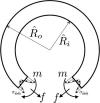Experimentally validated microstructural 3D constitutive model of coronary arterial media
- PMID: 21303183
- PMCID: PMC3249663
- DOI: 10.1115/1.4003324
Experimentally validated microstructural 3D constitutive model of coronary arterial media
Abstract
Accurate modeling of arterial response to physiological or pathological loads may shed light on the processes leading to initiation and progression of a number of vascular diseases and may serve as a tool for prediction and diagnosis. In this study, a microstructure based hyperelastic constitutive model is developed for passive media of porcine coronary arteries. The most general model contains 12 independent parameters representing the three-dimensional inner fibrous structure of the media and includes the effects of residual stresses and osmotic swelling. Parameter estimation and model validation were based on mechanical data of porcine left anterior descending (LAD) media under radial inflation, axial extension, and twist tests. The results show that a reduced four parameter model is sufficient to reliably predict the passive mechanical properties. These parameters represent the stiffness and the helical orientation of each lamellae fiber and the stiffness of the interlamellar struts interconnecting these lamellae. Other structural features, such as orientational distribution of helical fibers and anisotropy of the interlamellar network, as well as possible transmural distribution of structural features, were found to have little effect on the global media mechanical response. It is shown that the model provides good predictions of the LAD media twist response based on parameters estimated from only biaxial tests of inflation and extension. In addition, good predictive capabilities are demonstrated for the model behavior at high axial stretch ratio based on data of law stretches.
Figures












References
-
- Doyle JM, Dobrin PB. “Finite deformation analysis of the relaxed and contracted dog carotid artery.”. Microvasc Res. 1971;3(4):400–415. - PubMed
-
- von Maltzahn WW, Warriyar RG, Keitzer WF. “Experimental measurements of elastic properties of media and adventitia of bovine carotid arteries”. Journal of biomechanics. 1984;17(11):839–847. - PubMed
-
- Humphrey JD. Cardiovascular solid mechanics : cells, tissues, and organs. Springer; New York: 2002.
-
- Vito RP, Dixon SA. “Blood vessel constitutive models-1995-2002.”. Annu Rev Biomed Eng. 2003;5:413–439. - PubMed
-
- Holzapfel GA, Sommer G, Gasser CT, Regitnig P. “Determination of layer-specific mechanical properties of human coronary arteries with nonatherosclerosis intimal thickening and related constitutive modeling”. Am J Physiol Heart Circ Physiol. 2005;289:2048–2058. - PubMed
Publication types
MeSH terms
Grants and funding
LinkOut - more resources
Full Text Sources

